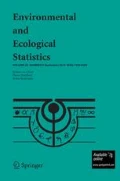Abstract
The Atlantic Slope Consortium (ASC) is a project designed to develop and test a set of indicators in coastal systems that are ecologically appropriate, economically reasonable, and relevant to society. The suite of indicators will produce integrated assessments of the condition, health and sustainability of aquatic ecosystems based on ecological and socioeconomic information compiled at the scale of estuarine segments and small watersheds. The research mandate of the ASC project is the following:
Using a universe of watersheds, covering a range of social choices, we ask two questions:
-
• How “good” can the environment be, given those social choices?
-
• What is the intellectual model of condition within those choices, i.e., what are the causes of condition and what are the steps for improvement?
As a basis for compiling ecological indicators, a watershed classification system was required for the experimental design. The goal was to develop approximately five categories of watersheds for each physiographic province, utilizing landscape and land use parameters that would be predictive of aquatic resource condition. All 14-digit Hydrologic Unit Code (HUC) watersheds in the Mid-Atlantic region would then be classified according to the regime. Five parameters were utilized for the classification: three land cover categories, consisting of forested, agricultural, and urban, median slope or median elevation, and total variance of land covers in 1-km-radius circles positioned on all stream convergence points in a specified 14-digit␣HUC watershed. Cluster analysis utilizing these five parameters resulted in approximately five well-defined watershed classes per physiographic province. The distribution of all watersheds in the Mid-Atlantic region across these categories provides a unique report on the probable condition of watersheds in the region.
Similar content being viewed by others
References
R.T.T. Forman M. Godron (1986) Landscape Ecology Wiley New York
Karr, J.R. and Chu, E.W. (1999) Restoring life in running waters: Better biological monitoring, Island Press, Washington DC, p. 206.
T.R. Loveland D.M. Shaw (1996) Multiresolution land characterization: Building collaborative partnerships J.M. Scott T.H. Tear F.W. Davis (Eds) Gap Analysis: A Landscape Approach to Biodiversity Planning American Society for Photogrammetry and Remote Sensing Bethesda 79–85
InstitutionalAuthorNameNational Research Council (NRC) (2000) Ecological Indicators for the Nation National Academy Press Washington, DC
T.J. O’Connell L.E. Jackson R.P. Brooks (2000) ArticleTitleBird guilds as indicators of ecological condition in the central Appalachians Ecological Applications 10 IssueID6 1706–21
Paul, J.F. (1998) Condition of the Mid-Atlantic Estuaries. EPA 600-R-98-147, USEPA, Office of Research and Development, Washington, DC.
M.J. Schuft T.J. Moser P.J. Wigington SuffixJr D.L. Stevens SuffixJr L.S. McAllister S.S. Chapman T.L. Ernst (1999) ArticleTitleDevelopment of landscape metrics for characterizing riparian-stream networks Photogrammetric Engineering and Remote Sensing 65 1157–67
USEPA (2003) A Science Advisory Board (SAB) Report: A Framework for Assessing and Reporting on Ecological Condition. EPA-SAB-EPEC-02–009A. US Environmental Protection Agency, Washington, DC.
D.H. Wardrop R.P. Brooks (1998) ArticleTitleThe occurrence and impact of in central Pennsylvania wetlands Environmental Monitoring and Assessment 51 119–30 Occurrence Handle10.1023/A:1005958429834
Author information
Authors and Affiliations
Corresponding author
Rights and permissions
About this article
Cite this article
Wardrop, D., Bishop, J., Easterling, M. et al. Use of landscape and land use parameters for classification and characterization of watersheds in the mid-Atlantic across five physiographic provinces. Environ Ecol Stat 12, 209–223 (2005). https://doi.org/10.1007/s10651-005-1042-5
Issue Date:
DOI: https://doi.org/10.1007/s10651-005-1042-5




